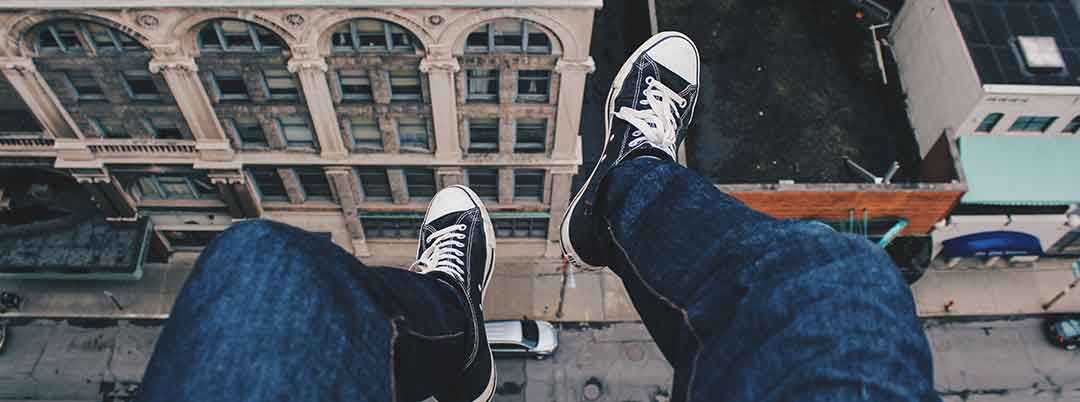
- Most (dare I say, all) of us are afraid of something, whether it be small spaces, heights, or snakes; and as it turns out, we often share the same fears.
- One common fear is social phobia: this fear is rooted in one’s fear of being judged or negatively perceived by other people.
- Next on the list is arachnophobia, or the fear of spiders; arachnophobes are often triggered by the sight of spiders but might panic even at the thought of these creatures.
- Many also fear open or crowded spaces, which is defined as agoraphobia—these individuals might fear public transportation, big crowds, or long lines.
- Claustrophobia, or the fear of getting stuck in an enclosed space, is also common; claustrophobic individuals might avoid entering elevators or small, windowless rooms.
- The final item on the list is acrophobia or the fear of heights; those with acrophobia may grow severely anxious about flying, staying on the 50th floor of a hotel, or riding roller coasters.
Do you freak out in tiny spaces? Are you deathly afraid of heights? Do you refuse to meet your friend’s pet snake? If you answered yes to any of these questions, you have something in common with much of the population. As it turns out, many of us share fears like tiny spaces, heights, snakes, and others. But what are the most common fears or phobias? Here’s a list of 5 widespread fears:
- Social Phobia: The Fear of Judgment or Rejection
The first on the list is social phobia, or social anxiety disorder, which is rooted in an individual’s fear of being negatively perceived, judged, or rejected by others. According to the Anxiety and Depression Association of America, roughly 15 million American adults suffer with social phobia. This fear and anxiety can make everyday functioning difficult, as it can cause individuals to avoid certain events, places, or people. In severe cases, those who suffer with social phobia may even hide out at home and rely exclusively on their loved ones for basic necessities.
An individual’s social anxiety may escalate in certain situations. For example, many experience the worst of their symptoms when they are the center of attention: say, they’re giving a presentation at the office or otherwise addressing a large group of people, all eyes on them.
- Arachnophobia: The Fear of Spiders
Arachnophobia is another common fear, with as many as 1 in 4 men and 1 in 3 women suffering with it. You’re probably familiar with this fear, but in case you aren’t, arachnophobia is the fear of spiders. While it’s often triggered by actually seeing a spider, even thinking about spiders can bring on extreme fear and anxiety.
Scientists have long been dumbfounded by the widespread fear of spiders—I mean, the majority of spiders aren’t poisonous or dangerous in any other sense. Yet, many of us lose our minds when we spot one nearby. A recent study concludes that this stress-reaction is deep-rooted, one we likely inherited from our ancestors who lived with and feared these creatures. You might be wondering why they feared these creatures. It’s possible that spiders posed a greater threat to our ancestors who didn’t yet have the ability to heal from spider bites or other injuries sustained from encounters with insects.
- Agoraphobia: The Fear of Open or Crowded Spaces
The third item on our list is agoraphobia, or the fear of open or crowded spaces. The following are typically what bring on stress and anxiety characteristic of this phobia: large open spaces, public transportation, and leaving the house alone. It’s estimated that around 1.8 million Americans suffer with agoraphobia.
This phobia can cause its sufferers serious distress, both physically and mentally. Here are a few common symptoms:
- Rapid heartbeat
- Sweating
- Trembling or shaking
- Dizziness and nausea
- Fear of dying
- Claustrophobia: The Fear of Tight Spaces
Claustrophobia, on the other hand, is the fear of being stuck in an enclosed space. So, for example, those with claustrophobia may get nervous inside elevators or small rooms without windows—even wearing too-tight clothes can cause panic. Estimates say that around 5-7% of the world population struggle with this phobia.
People with claustrophobia will often do whatever they can to avoid situations that may trigger their anxiety. For instance, they’ll take the stairs instead of the elevator, even when they need to climb 30 floors; similarly, they’ll walk instead of ride the metro, even when they have to travel more than a couple miles.
- Acrophobia: The Fear of Heights
Last on the list is acrophobia or the fear of heights. This fear may make one reluctant to fly in planes, ride roller coasters, stay in tall buildings, or even drive over bridges. While many of us experience nerves when we look over a balcony on the 50th floor or sit atop the tallest hill of a roller coaster, those with a true phobia (which is estimated to be about 5% of the population) experience unpleasant symptoms like:
- Sweating and shaking
- Feeling paralyzed
- Uncontrollable crying or screaming
- Panic attack
- Headaches and dizziness
There are a few pieces of good news. First, it’s normal to have fears. You aren’t a freak if you’re afraid of heights or spiders or something that didn’t make this list. Second, if you suffer because of your fear or phobia, there is help out there. Consider meeting with a mental health professional who can assist you in understanding, addressing, and managing your fear—be it of social rejection, spiders, open or tight spaces, heights, or something different entirely. In any regard, a counselor—specifically one who specializes in treating anxiety like Lindsey Reed, licensed clinical social worker, from Thriveworks Manassas—can help.
Let’s keep in touch! Sign up to receive our newsletter:
Start a Relationship with An Exceptional Counselor
- Skilled and caring professional counselors
- Accepting all major and most insurances
- High-touch customer service & premium benefits
- Same- or next-day appointments
- Ultra-flexible 23.5hr cancellations













